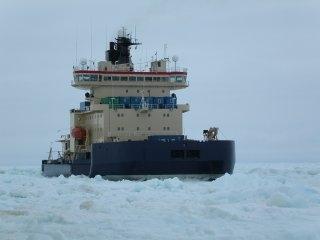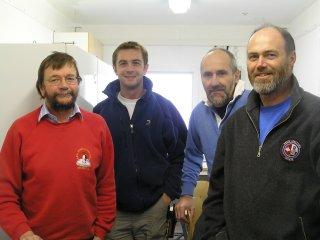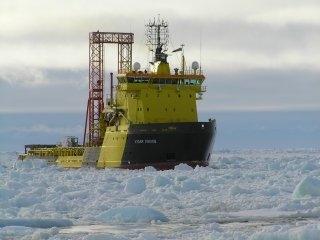28 August, 2004
Bits and Pieces from Aboard the Oden
We are still awaiting core samples, though the good news is that the
drilling has resumed and we have reached almost 270 meters below the sea
bed. The drilling crew has experienced some mechanical difficulties which
have delayed the drilling. It is a good feeling when the ship is moving
again and breaking ice because we know we are back on track and working.
While onboard the Oden as part of this expedition, I have been
trying to understand the many acronyms that have been flying around this
expedition. The expedition itself is called ACEX (Arctic Coring Expedition).
It is the second coring expedition of the newly formed Integrated Ocean
Drilling Program (IODP). The IODP, an international scientific ocean
drilling program, succeeded the ODP (the Ocean Drilling Program) that had
operated from 1985 - September 2003. Under ODP, the United States supported
by the NSF (National Science Foundation) and 20 other international partners
combined resources to provide one drilling vessel, the JOIDES Resolution.
The US provided approximately 65% of the total program resources. In the new
IODP, the US and Japan will serve as equal partners in providing operating
expenses to the IODP, and a consortium of at least 13 European countries
will also contribute significantly. The capitalization costs for each
platform are paid for by the sponsoring entity. Japan is building a new
drill ship called the Chikyu (which means "Earth") that should be ready in
2007. Capitalization costs are somewhat greater than $0.5 billion US.
I have spent considerable time on this expedition talking with
the crew from the BGS (British Geological Survey). The BGS co-ordinates ESO
(the ECORD Science Operator), a consortium that also includes the University
of Bremen and the European Petrophysics Consortium. In turn ECORD (European
Consortium for Ocean Research Drilling) is comprised of the 13 European
countries mentioned above.
ESO is responsible for managing and operating the ACEX expedition. To help
them with this enormous task they contracted the SPRS (Swedish Polar
Research Secretariat), and together they were responsible for securing all 3
vessels - the 2 icebreakers, the Oden and the Sovetskiy Soyuz, as well as
outfitting the icebreaker Vidar Viking as a drill ship. SPRS also organized
the fleet- and ice-management teams.
To turn the Vidar into a drill ship, the ESO first needed to add
a "moon pool", a hole in the deck of the ship for the drill string to pass
through. The BGS also contracted a British company, Seacore, to build a
drilling derrick and to conduct drilling operations at sea. The derrick atop
the Vidar is not as tall as the one on the JOIDES Resolution, so rather than
pulling up core lengths of 9.5 meters, ACEX is coring in 4.5 meter lengths.
Getting the Vidar ready for drilling was a feat in time-management. The
entire outfitting of the Vidar by ESO began on July 22 in Aberdeen, Scotland
with the cruise set to begin on August 7th. Sea trials of the drilling
equipment took place in the North Sea starting on July 28th and ended in
Landskrona, Sweden on the 1st of August. Then the Vidar needed to make its
way north to Tromso, Norway, where it met up with the Oden.
As it turned out, the Oden sailed at about midnight on August
7th, with the Vidar following after some final preparations. We met again at
the ice edge on August 10th and have been together since then in the Arctic
ice.

The Oden as seen from the Vidar Viking, photo by Erik Zetterberg.

Some of the BGS crew, Colin Brett, Dave McInroy, Dan Evans and Colin Graham.

The drill ship, Vidar Viking.
Contact the TEA in the field at
.
If you cannot connect through your browser, copy the
TEA's e-mail address in the "To:" line of
your favorite e-mail package.
|
